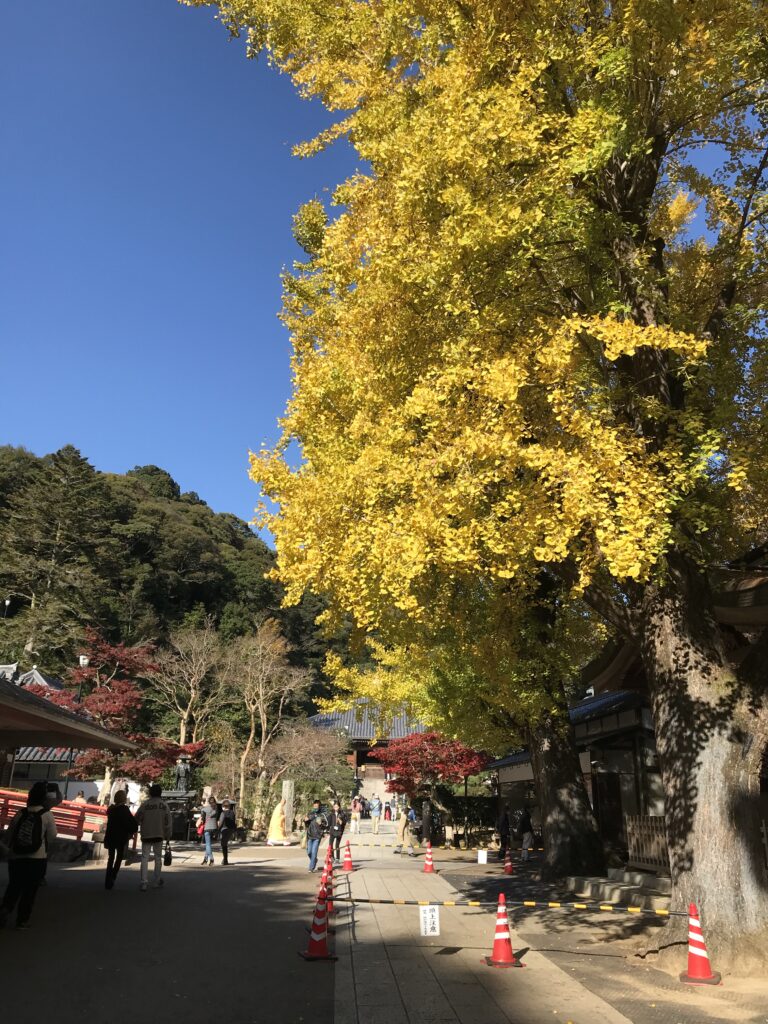神社か、お寺かどっちなの?
阪急宝塚線の宝塚駅手前に清荒神駅があります。ここにあるのが清荒神清澄寺です。駅名が清荒神なので、神社だと思っていましたが、どうも実態は違うようです。正式名称は蓬莱山清澄寺といい、真言宗18本山の一つで、宇多天皇の勅願で創建されたそうです。

お店が並ぶ駅からの参道が楽しい
駅から参道を歩くと、鳥居が出てきます。清澄寺の鎮守社として三宝荒神社が設けられていたのが、荒神信仰と真言三宝宗の神仏習合から、「清荒神清澄寺」の名前で知られるようになりました。駅からの参道には沢山の飲食店、土産物だけでなく日用雑貨や骨とう品などを売る店が並んでいて、歩いているだけでも楽しい雰囲気がします。

山門をくぐると、まっすぐ奥に本堂が見えています。その手前に一願地蔵尊が立ち、多くの方が柄杓で水をすくって、この地蔵さんに水を掛けてお祈りをしています。そうするとご利益があるそうです。私も皆さんの真似をして、水を一杯かけてからお祈りをしました。

終末に来たこともあり、境内は多くの人でにぎわっていました。境内をブラブラ散策していると、10年以上前に来たことを思い出しました。阪急電鉄の沿線七福神めぐりの中で、布袋さんの場所としてスタンプを集めた記憶があります。今回は、スタンプではなく御朱印をいただきました。

沢山の厄除火箸が奉納される
ここの鎮守社は、お寺の境内の参道から階段で上がっていきますが、お寺と同じくらい大きくて立派な拝殿が目の前に現れます。ここには火箸納所という建物があって、たくさんの火箸が奉納されて積まれています。厄年の人は、荒神さんの厄除火箸を家に祀って厄をつまみ出してもらうそうです。そのお役目を終えた火箸が奉納されています。いろいろな習慣があって、おもしろいですね。(完)

清荒神清澄寺の御朱印

清荒神清澄寺が紹介されている書籍
神仏霊場会の公式ガイドブックに清荒神清澄寺が紹介されています。

神と仏の道を歩く 神仏霊場巡拝の道公式ガイドブック (集英社新書ヴィジュアル版) [ 神仏霊場会 ]
価格:1,466円
(2021/5/6 09:24時点)
感想(5件)
Kiyoshikojin Seichoji Temple
Kiyoshikojin Station is located just before Takarazuka Station on the Hankyu Railway Takarazuka Line. Located here is the Kiyoshikojin Seichoji Temple. Since the name of the station is Kiyoshikojin, I thought it was a shrine, but it seems that it is not. Its official name is Horai-san Seichoji Temple, one of the 18 head temples of the Shingon sect of Buddhism, and it was built at the behest of Emperor Uda.
Walking along the approach from the station, you will see a torii gate. Sanpo-arakajinsha was established as a Shinto shrine for Seichoji Temple, and it became known as “Sei-arakajin Seichoji Temple” due to the combination of Aragami beliefs and the Shinto and Buddhist teachings of the Shingon Sanpo-shu sect. The approach to the temple from the station is lined with many restaurants, stores selling not only souvenirs but also daily necessities and antiques, creating a pleasant atmosphere just by walking around.
After passing through the gate, the main hall can be seen straight ahead. In front of the main hall stands Ichigan Jizo-son, and many people pray to him by pouring water over him with a ladle. It is said that doing so brings good luck. I followed their example and poured a cup of water over the Jizo before praying.
Since I came at the end of the year, the temple grounds were crowded with people. As I strolled around the temple grounds, I remembered that I had come here more than 10 years ago. I remember that I had collected stamps as the place of Hotei-san in the Seven Lucky Gods Tour along the Hankyu Railway line. This time, I received a red seal instead of a stamp.
The chinju-sha here is reached by stairs from the approach to the temple grounds, and a magnificent worship hall, as large and magnificent as the temple itself, appears in front of you. There is a building here called the hibashi-no-sho, where many hibashis are dedicated and piled up. People who are in a bad year are said to enshrine Kojin-san’s tongs in their houses to have them pick out the bad luck from their houses. The tongs that have finished their work are dedicated to the god. It is interesting to see the various customs. (End)

価格:8,640円
(2022/8/10 13:06時点)
感想(898件)
Temple Seichoji de Kiyoshikojin
La station Kiyoshikojin est située juste avant la station Takarazuka sur la ligne Hankyu Railway Takarazuka. C’est là que se trouve le temple Kiyoshikojin Seichoji. Comme le nom de la station est Kiyoshikojin, je pensais qu’il s’agissait d’un sanctuaire, mais il semble que ce ne soit pas le cas. Son nom officiel est Horai-san Seichoji Temple, l’un des 18 temples principaux de la secte bouddhiste Shingon, et il a été construit à la demande de l’empereur Uda.
En marchant le long de l’approche de la gare, vous verrez une porte torii. Le Sanpo-arakajinsha a été établi comme un sanctuaire Shinto pour le temple Seichoji, et il est devenu connu sous le nom de “Temple Seichoji Sei-arakajin” en raison de la combinaison des croyances Aragami et des enseignements Shinto et Bouddhistes de la secte Shingon Sanpo-shu. L’approche du temple depuis la gare est bordée de nombreux restaurants, de magasins vendant non seulement des souvenirs mais aussi des produits de première nécessité et des antiquités, créant une atmosphère agréable rien qu’en se promenant.
Après avoir franchi la porte, on peut voir le hall principal droit devant. Devant le hall principal se trouve Ichigan Jizo-son, et de nombreuses personnes le prient en versant de l’eau sur lui avec une louche. On dit que cela porte chance. J’ai suivi leur exemple et j’ai versé une tasse d’eau sur le Jizo avant de prier.
Comme je suis venu à la fin de l’année, le temple était bondé de monde. En me promenant dans l’enceinte du temple, je me suis souvenu que j’étais venu ici il y a plus de 10 ans. Je me souviens que j’avais collecté des timbres comme le lieu de Hotei-san dans le circuit des sept dieux chanceux le long de la ligne de chemin de fer Hankyu. Cette fois, j’ai reçu un sceau rouge au lieu d’un timbre.
On accède au chinju-sha par des escaliers depuis l’approche du terrain du temple, et une magnifique salle de culte, aussi grande et magnifique que le temple lui-même, apparaît devant vous. Il y a ici un bâtiment appelé le hibashi-no-sho, où de nombreux hibashis sont dédiés et empilés. On dit que les gens qui sont dans une mauvaise année enchâssent les pinces de Kojin-san dans leurs maisons pour qu’elles enlèvent la malchance de leurs maisons. Les pinces qui ont terminé leur travail sont dédiées au dieu. Il est intéressant de voir les différentes coutumes. (Fin)
